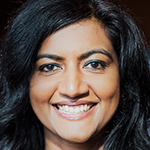Maryland Stem Cell Research Fund: Cutting-edge regenerative medicine
The Maryland Stem Cell Research Fund (MCSRF) is devoted to developing and supporting innovative research into all aspects of stem-cell-based technologies. Through its diverse program structure, the MSCRF is intimately involved in every stage of the stem cell journey – from pre-clinical lab discovery to clinical patient trials. Importantly, it remains forward thinking, ensuring the next generation of researchers have the resources and the capability to undertake ongoing research. Research Outreach spoke to Dr Amritha Jaishankar, Executive Director of MSCRF, about her work with the organization, the wider context of regenerative medicine, and the future of stem-cell-based treatments and cures.
Throughout her career with MSCRF, Dr Amritha Jaishankar has managed and overseen numerous stem-cell-related research projects. She was instrumental in the establishment of the successful “Accelerating Cures” initiative and is highly qualified to talk us through the important work being undertaken in the stem cell community. Her work with the MSCRF is holistic, covering everything from laboratory research to commercial business support. We learnt more about her professional background and her hopes for a future of successful stem-cell-based research.
What is the mission of the Maryland Stem Cell Research Fund?
At the Maryland Stem Cell Research Fund in Maryland, US, we are focused on identifying and fostering cutting-edge research and innovation in the field of regenerative medicine. Our mission is to develop new medical strategies for the prevention, diagnosis, treatment and cure of human diseases, injuries and conditions through human stem cells. Our goal at MSCRF is to accelerate stem cell research, commercialization and cures.

Executive Director of MSCRF
Can you tell me more about your background?
I currently serve as the Executive Director of the Maryland Stem Cell Research Fund.
I’ve been interested in science for as long as I can remember. I grew up in the southern part of India, and through school and college I was drawn to understanding (and solving) genetic diseases and gene therapy. I moved to Leicester, UK, to gain hands-on research skills in this field, and upon graduating at the top of my master’s class there, I was offered a fellowship to pursue a PhD in Genetics, which brought me to America. I first started working with stem cells here and was especially drawn to their role in brain development. This led me to the National Institutes of Health (NIH) where I started my postdoctoral work. This gave me the opportunity to be a founding member of a non-profit institute at the Johns Hopkins School of Medicine, where I worked in collaboration with various industry partners to advance treatments for neurodevelopmental disorders.
It is truly exciting to identify the next technology at the very outset – in its infancy when it’s just an idea.
In 2016 I joined the MSCRF to spearhead an “Accelerating Cures” initiative. I have always been passionate about advancing therapies to patients in need; this is what drove me to be a scientist. My training across various countries and my experience inside and outside the laboratory put me in a unique position to be able to drive change and serve as a champion for the regenerative medicine field.

What does your role as Executive Director entail?
In my role as the Executive Director of the Maryland Stem Cell Research Fund, I oversee all MSCRF activities and our six programs accelerating stem cell research, commercialization, and cures. I remain committed to helping our scientists, physicians and companies advance their research and deliver cures to patients in need. With over $170M in over 500 stem cell/cell therapy projects in Maryland, we lead the way in identifying and supporting the most promising stem cell technologies in our region. I will continue my efforts to grow MSCRF, increase our impact and build a collaborative stem cell community so we can advance science and accelerate cures together.
You offer six different programs to advance human stem cell-based technologies. Could you tell me more about each program?
MSCRF offers six different funding opportunities – Launch, Discovery, Validation, Commercialization, Clinical and Postdoctoral Fellowship. Our programs are designed around what it takes to transition the most promising discoveries from the labs where the invention occurred, to the clinic where they will be offered to patients, as well as a mechanism to train the next generation of stem cell scientists and leaders. You can learn about each of our programs and find a detailed Request for Applications (RFA) for each here or on the MSCRF App, or reach out to me!


Briefly, our Commercialization Program helps Maryland-based start-up companies or established companies that are developing a new stem cell product. Our Clinical Program supports organizations that wish to conduct stem cell/cell therapy clinical trials in the State of Maryland. The Discovery and Validation programs support faculty advancing cutting-edge stem cell research and technologies. The Fellowship program provides stem cell research postdoctoral training for recent graduates. Last year, we also created the Launch program to support new or new-to-the field faculty to bring novel thought and orthogonal expertise to the stem cell field. I am actively engaged with our stem cell community and we work with the Stem Cell Research Commission (our Board) to routinely evaluate and redesign our programs to address critical gaps and needs in the regenerative medicine industry.
Tell me about a project that inspired you or that you are most proud of.
I am incredibly proud of every project we support, and I am inspired each day by the scientists, physicians and perhaps above all, by the patients we help. I trained as a stem cell scientist and have been a part of this community in different roles for well over a decade and devoted my entire professional career to advancing this field, so this is personal to me. MSCRF, while committed to advancing regenerative medicine, is disease agnostic; this means we have a broad impact across a wide range of disease indications and conditions. We’ve funded projects addressing disease indications such as cancer, diabetes, heart disease, stroke, Alzheimer’s etc. that are amongst the top 10 leading causes of death in Maryland. We’ve also supported work to address ARDS, a COVID-19 related complication that results in fatalities.

Stay connected to us to hear more about how our projects have helped infants with blood disorders, amputees including wounded warriors, cancer patients and much more.
It’s truly exciting to identify the next best technology at the very outset – in its infancy when it’s just an idea even – and to help shape it, and it’s also incredibly rewarding to see these advance to the clinic, helping a wide range of patients.
Looking into the future, what does MSCRF aim to achieve? Which scientific advances are you most excited about and what are the biggest challenges in this field?
Our goal at MSCRF is to accelerate stem cell research, commercialization, and cures. We remain committed to translating scientific excellence and developing cures for debilitating diseases. We are proactive about identifying the next promising technology or company, and providing them with the resources they need to enable their success. We look forward to growing to meet the needs of our community, expanding our impact, creating collaborations, and Accelerating Cures together.

This is an incredibly exciting time to be in this field – we’ve seen remarkable advances in genetic engineering of cells, we are seeing cell and gene therapies deliver cures for devastating diseases, we are seeing innovations in tissue engineering move us towards organ-level therapies. As we watch the scientific advances unfold, it appears only imagination (and capital) limits where this field can go.
At MSCRF we encourage high-risk/high-reward innovations, we help create value and de-risk these technologies, we bring scientists with orthogonal expertise and ideas into this field to address the emerging challenges and to rapidly (and collaboratively) advance science. We’re fortunate to have a front seat to witness some of the most exciting discoveries. As the field progresses, challenges with scale-up/cost-effective manufacturing, distribution and pricing/reimbursement remain hurdles that this community and key stakeholders continue to come together to address.
We will continue to build this community with a common purpose to advance science and improve human health.
2020 created unprecedented access and scientific collaboration and we will aim to maintain that level of engagement with our industry and key stakeholders. I am dedicated to building a thriving cell therapy ecosystem and creating a strong network, and this has been key to our success. This industry is working towards changing healthcare as we know it but we don’t do this alone – whether you are a patient/patient advocate, disease foundation, stem cell agency, cell therapy company, scientist or investor, I am open to collaborations. Join us on this journey as we build, support and lead this community towards realizing the promise of this field and as we accelerate cures to patients in need.
As we aim to accelerate cures, we also have to scale our resources and accelerate our timelines; so we have various internal operational and process/policy development goals because I aim to innovate, improve, and deliver excellence, just as I expect those we work with to do the same. Above all, we will continue to build this community and bring us all together with a sense of urgency and a common purpose to advance science and improve human health.

What advice would you give someone that is interested in working in the regenerative medicine industry?
Do it! Honestly, I may be a bit biased but there isn’t a better industry to be a part of right now. It is a rapidly growing industry that is poised to revolutionize healthcare and have a profound impact on human health. There are opportunities for individuals at different stages of their careers to get involved and contribute to this field now.
Could you tell us about this year’s World Stem Cell Summit?
It was a great event that showcased every aspect of the regenerative medicine field and the rapid progress we are making as an international community. I was honoured to join leading stem cell experts from around the world to discuss how we can integrate forces to accelerate cell-based therapies for unmet medical needs. It was a pleasure to be a speaker and chair a session with organizations and leaders with whom I share a complete alignment of interests and a common purpose, and we had a great conversation around key initiatives, funding and collaborations that drive discovery and cures. I was also joined by several members of the MSCRF community, either as speakers in the course or attending various parts of the conference which provided a great overview of the key technologies, hot topics and future trends in the field as well as a thoughtful discussion of regulatory strategies and pathways, patient advocacy and patient access and adoption. While we missed seeing familiar faces and colleagues in person, it was truly enjoyable to spend a week immersed in the most exciting field with a group of equally passionate and committed individuals.
